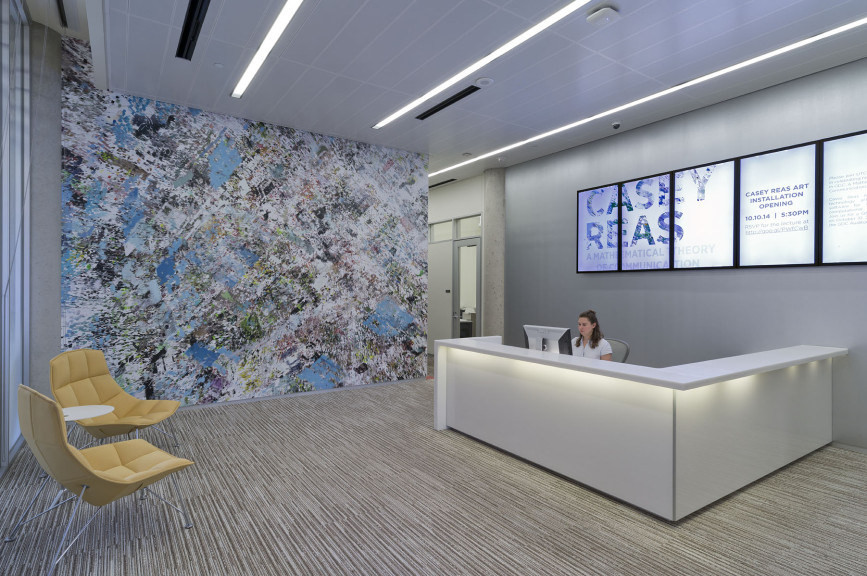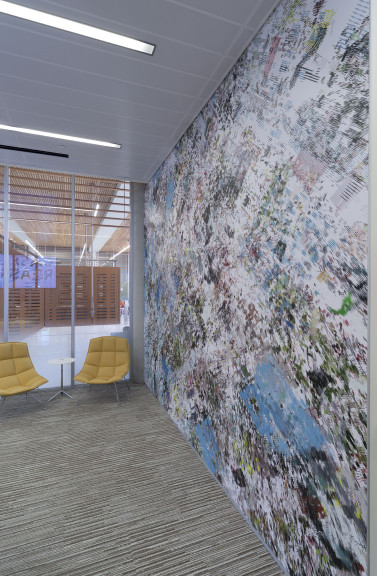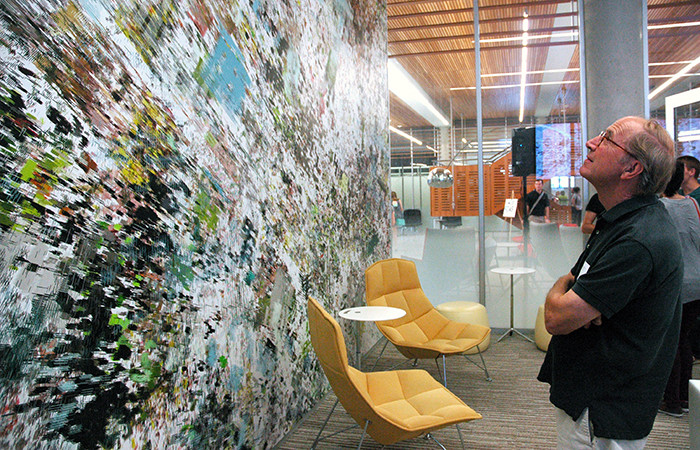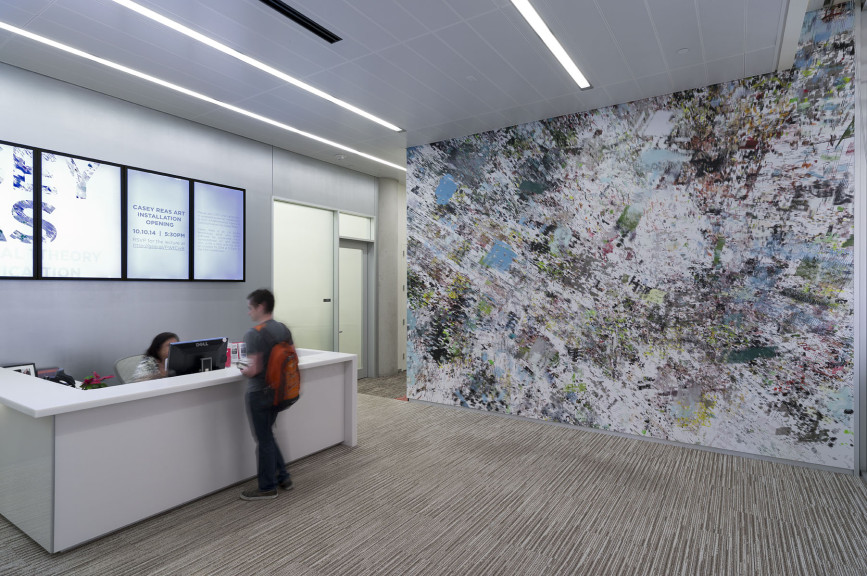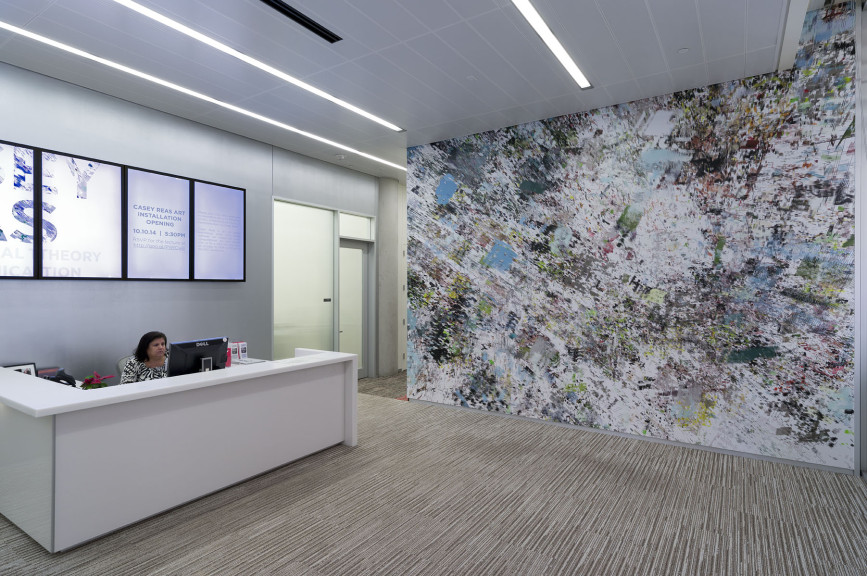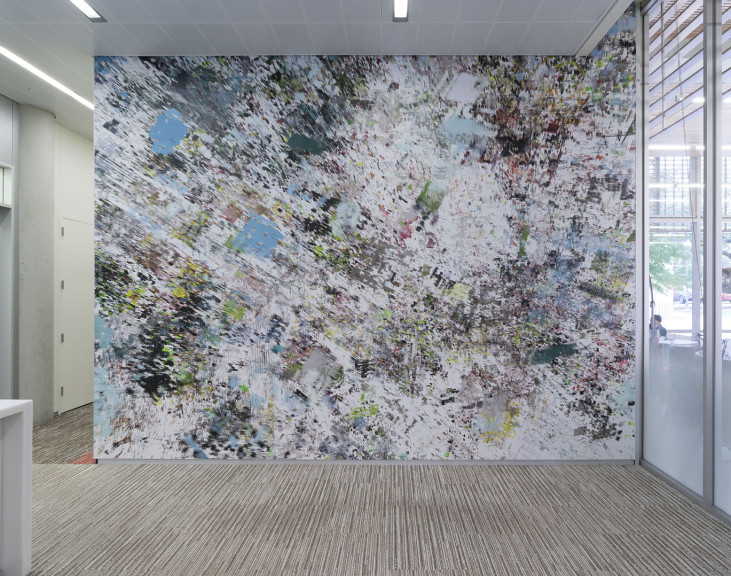Casey Reas is one of the leading artists in the genre of software art, defining both the practice in this field and the theoretical discourse surrounding it. Reas typically explores systems, specifically their emergence and underlying conditions with an instruction-based practice rooted in conceptual art. A Mathematical Theory of Communication blends conceptual art and information science by merging aspects of both to create an experiential data landscape. For this commission, Reas captured television images with an antenna, then processed the images using algorithms—or “instructions”—he designed. The images were inkjet printed to create the mural on two walls.
More information
A Mathematical Theory of Communication by Casey Reas bridges the gap between the technical world of programming and the visual realm of art and design. His project is accessible in the atrium of the Gates Dell Complex during regular building hours.
In 2013 the Chair of the Department of Computer Science, Bruce Porter, requested Landmarks assistance in acquiring art to enhance two walls in the department’s administrative and academic office suites. Landmarks identified artists whose work would complement the Sol LeWitt pieces that had been installed when the building was constructed in 2012. After reviewing a range of possibilities, Landmarks and the computer science’s project committee agreed that artist Casey Reas was the best choice for the commission.
A Mathematical Theory of Communication is composed of high-resolution digital prints on a fine art substrate proprietary to Maharam, the manufacturer and printer.
Funding for this project was provided by the Department of Computer Science. Landmarks would like to thank the department for its continued support. For their dedication and assistance, Landmarks would also like to thank:
Leadership
Andrée Bober and Landmarks
Pat Clubb and University Operations
Douglas Dempster and the College of Fine Arts
Landmarks Advisory Committee
Bruce Porter and the Department of Computer Science
William Powers and the Office of the President
Bob Rawski and the Office of Facilities Planning and Construction
David Rea and the Office of Campus Planning
Project Team
Andrée Bober, curator and director, Landmarks
Nisa Barger, project manager, Landmarks
Casey Reas, artist
Special Thanks
Lorenzo Alvisi, Department of Computer Science
Bill Butler, Pelli Clark Pelli Architects
Coburn & Company
Adam Klivans, Department of Computer Science
Matt Larson, Department of Computer Science
Maharam
Nick Nobel, external affairs, Landmarks
Christiane Paul, curatorial contributor
Steven Sacks, bitforms gallery
Patti Spencer, Department of Computer Science
Stephanie Taparauskas, development, Landmarks
Jennalie Travis, development, Landmarks
Matthew Walker, Department of Computer Science
Catherine Zinser, education, Landmarks
Landmarks to unveil new Casey Reas installation on UT campus
Justin Boyle, CultureMap Austin, 09 October 2014
Why do we need public art, you ask? One reason, as this book aptly notes, is no language on Earth has ever produced the expression, “As pretty as an institutional construction project.”
Consider ‘A Mathematical Theory of Communication’
Mike Lee, KUT, 03 October 2014
UT’s Landmarks public art program is dedicated to getting as much art as possible into public places on the University of Texas campus and around Austin.
A Mathematical Theory of Communication
CodaWorx, 2014
A Mathematical Theory of Communication" is a large-scale, computer-generated mural in The Bill & Melinda Gates Computer Science Complex & Dell Computer Science Hall at The University of Texas at Austin.
A Mathematical Theory of Communication
Americans for the Arts Public Art Network Year in Review Database, 2014
A Mathematical Theory of Communication is a large-scale, computer generated mural covering two walls near the main atrium of the Gates Dell Complex, home to the Department of Computer Science on The University of Texas at Austin campus.
LANDMARKS PRESENTS ARTIST CASEY REAS
CASEY REAS
The conceptual works of Casey Reas bridge the gap between the technical world of programming and the visual world of art and design. Reas writes software that derives from short text instructions or “rules” that are expressed in different media, including natural language, computer code, animated simulations, and static images. His dynamic, emergent software employs programming as his paintbrush, allowing a machine to create the unexpected, intricate visuals seen in Reas’ final rendered images.
Reas completed graduate studies and research in the Aesthetics and Computation Group at the MIT Media Lab, building on a bachelor’s degree earned from the School of Design at the University of Cincinnati. During his time at MIT, Reas and his colleague Ben Fry developed Processing, an open-source programming language that gives designers tools to creatively express themselves through software. Today, hundreds of thousands of students, artists and designers use Processing for learning, prototyping and production.
Reas has exhibited his work in festivals and galleries all over the world. His work has been featured in more than one hundred solo and group exhibitions, including shows at the San Francisco Museum of Modern Art and the Art Institute of Chicago. Recent commissions include work for the Whitney Museum of American Art in New York and the New World Symphony in Miami.
Reas currently lives and works in Los Angeles, where he is as an associate professor in the Department of Design Media Arts at The University of California, Los Angeles.
THE INSTALLATION: A MATHEMATICAL THEORY OF COMMUNICATION
Located at the Gates Dell Complex (GDC), A Mathematical Theory of Communication is a large-scale, computer generated mural covering two walls near the main atrium of the complex. His installation is the third public art piece associated with the GDC, complementing two works by Sol LeWitt installed onsite in 2013. Inspired by LeWitt’s work, Reas’ installation explores the relationship between his process and LeWitt’s techniques; where Reas’ images are manifestations of programs by computers, LeWitt’s are manifestations of “programs” by people.
Taking its title from Claude Shannon’s The Mathematical Theory of Communication, Reas’ visuals, created by generating thousands of images with infinite variations, play with the idea that information is circling around us at all times—in radio waves, microwaves, satellites, etc. Reas’ work captures that information and transforms it into an algorithm that produces images.
Landmarks and The University of Texas at Austin’s Department of Computer Science will unveil this installation on October 10, 2014.
ABOUT LANDMARKS
Landmarks is the public art program of the University of Texas at Austin. Landmarks brings fine works of art to the main campus to support the university as a leading research institution, enhance its aesthetic character, and provide a source of civic pride and welfare. Since 2008, Landmarks has acquired and exhibited more than thirty contemporary works by renowned and emerging artists. These public artworks are displayed across the campus landscape and are viewed by thousands of people every day.
Landmarks also provides supplemental education opportunities to foster engagement and learning with the collection and the artists, including free public tours (docent-led, walking, audio, or bike), bibliographic materials in the Fine Arts Library, children’s activity guides, and an ongoing program of lectures and events.
Discover more about Casey Reas and A Mathematical Theory of Communication by visiting the collection page.
Contact
Landmarks
The University of Texas at Austin
College of Fine Arts
2616 Wichita St., A7100
BWY 3rd Floor
Austin, TX 78712
info@landmarksut.org
512.495.4315
Press Office
An Phung
Digital Content Coordinator
Landmarks
an.phung@landmarksut.org
512.232.5904

